Combining 3D Geological Modeling and 3D Spectral Modeling for Deep Mineral Exploration in the Zhaoxian Gold Deposit, Shandong Province, China
Abstract
1. Introduction
2. Deposit Geology and Mineralization
3. Materials and Methods
3.1. 3D Geological Modeling
3.2. Spectral Analysis
4. Results
4.1. 3D Geological Model
4.1.1. 3D Fault Modeling
4.1.2. 3D Ore-Body and Au Grade-Interpolation Modeling
4.1.3. 3D Alteration-Zone Modeling
4.2. Interpretation Based on SWIR Spectra
4.3. Alteration Features and Zonation
4.3.1. No. 88 Exploration Line
4.3.2. Spatial Distribution of Alteration-Zone Minerals in the Section of No. 88 Exploration Line
4.4. Spectral Characteristics of Sericite
4.4.1. Al–OH Feature Wavelength Pos2200
4.4.2. Al–OH Feature Depth 2200D
4.4.3. Illite Crystallinity SWIR-IC Value
5. Discussion
5.1. Metallogenic Center Indication
5.2. Mineral-Exploration Indications
6. Conclusions
Author Contributions
Funding
Data Availability Statement
Acknowledgments
Conflicts of Interest
References
- Li, P.; Li, J.; Ma, Z. Preference of China s gold resources overseas investment. China Min. Mag. 2021, 30, 23–29. (In Chinese) [Google Scholar]
- Deng, J.; Yang, L.-Q.; Groves, D.I.; Zhang, L.; Qiu, K.-F.; Wang, Q.-F. An integrated mineral system model for the gold deposits of the giant Jiaodong province, eastern China. Earth-Sci. Rev. 2020, 208, 103274. [Google Scholar] [CrossRef]
- Yang, L.; Deng, J.; Wang, Z.; Guo, L.; Li, R.; Groves, D.I.; Danyushevsky, L.V.; Zhang, C.; Zheng, X.; Zhao, H. Relationships between gold and pyrite at the Xincheng gold deposit, Jiaodong Peninsula, China; implications for gold source and deposition in a brittle epizonal environment. Econ. Geol. Bull. Soc. Econ. Geol. 2016, 111, 105–126. [Google Scholar] [CrossRef]
- Deng, J.; Wang, J.P.; Peng, R.M.; Liu, J.; Yang, L. Researches on deep ore prospecting. Miner. Depos. 2004, 23, 142–149. [Google Scholar]
- Yang, L.; Deng, J.; Wang, Z.L.; Liang, Z.; Guo, L.N.; Song, M.C.; Zheng, X.L. Mesozoic gold metallogenic system of the Jiaodong gold province, eastern China. Acta Petrol. Sin. 2014, 30, 2447–2467. [Google Scholar]
- Deng, J.; Wang, C.; Bagas, L.; Carranza, E.J.M.; Lu, Y. Cretaceous-Cenozoic tectonic history of the Jiaojia Fault and gold mineralization in the Jiaodong Peninsula, China: Constraints from zircon U-Pb, illite K-Ar, and apatite fission track thermochronometry. Miner. Depos. 2015, 50, 987–1006. [Google Scholar] [CrossRef]
- Yu, X.; Yang, D.; Li, D.; Shan, W.; Xiong, Y.; Chi, N.; Liu, P.; Yu, L. Mineralization characteristic and geological significance in 3000 m depth of Jiaojia gold metallogenic belt, Jiaodong Peninsula. Acta Petrol. Sin. 2019, 35, 2893–2910. [Google Scholar]
- Zhu, D.; Zhang, W.; Wang, Y.; Tian, J.; Liu, H.; Hou, J.; Gao, H.L. Characteristics of ore bodies and prospecting potential of Zhaoxian gold deposit in Laizhou City of Shandong Province. Shandong Land Resour. 2018, 34, 14–19. [Google Scholar]
- Duke, E.F. Near infrared spectra of muscovite, Tschermak substitution, and metamorphic reaction progress: Implications for remote sensing. Geology 1994, 22, 621–624. [Google Scholar] [CrossRef]
- Green, D.; Schodlok, M. Characterisation of carbonate minerals from hyperspectral TIR scanning using features at 14,000 and 11,300 nm. Aust. J. Earth Sci. 2016, 63, 951–957. [Google Scholar]
- Laukamp, C.; Cudahy, T.; Thomas, M.; Jones, M.; Cleverley, J.S.; Oliver, N.H. Hydrothermal mineral alteration patterns in the Mount Isa Inlier revealed by airborne hyperspectral data. Aust. J. Earth Sci. 2011, 58, 917–936. [Google Scholar] [CrossRef]
- Laukamp, C.; Salama, W.; Gonzalez-Alvarez, I. Proximal and remote spectroscopic characterisation of regolith in the Albany-Fraser Orogen (Western Australia). Ore Geol. Rev. 2016, 73, 540–554. [Google Scholar] [CrossRef]
- Thompson, A.J.; Hauff, P.L.; Robitaille, A.J. Alteration mapping in exploration: Application of short-wave infrared (SWIR) spectroscopy. SEG Discov. 1999, 39, 1–27. [Google Scholar] [CrossRef]
- Jones, S.; Herrmann, W.; Gemmell, J.B. Short-wavelength infrared spectral characteristics of the RW horizon: Implications for exploration in the Myra Falls volcanic-hosted massive sulfide camp, Vancouver Island, British Columbia, Canada. Econ. Geol. 2005, 100, 273–294. [Google Scholar] [CrossRef]
- Yang, K.; Browne, P.R.L.; Huntington, J.F.; Walshe, J.L. Characterising the hydrothermal alteration of the Broadlands–Ohaaki geothermal system, New Zealand, using short-wave infrared spectroscopy. J. Volcanol. Geotherm. Res. 2001, 106, 53–65. [Google Scholar] [CrossRef]
- Laakso, K.; Peter, J.M.; Rivard, B.; White, H.P. Short-wave infrared spectral and geochemical characteristics of hydrothermal alteration at the Archean Izok Lake Zn-Cu-Pb-Ag volcanogenic massive sulfide deposit, Nunavut, Canada: Application in exploration target vectoring. Econ. Geol. 2016, 111, 1223–1239. [Google Scholar] [CrossRef]
- de Kemp, E.A.; Schetselaar, E.M.; Hillier, M.J.; Lydon, J.W.; Ransom, P.W. Assessing the workflow for regional-scale 3D geologic modeling: An example from the Sullivan time horizon, Purcell Anticlinorium East Kootenay region, southeastern British Columbia. Interpretation 2016, 4, SM33–SM50. [Google Scholar] [CrossRef][Green Version]
- Wang, G.; Zhang, Z.; Li, R.; Li, J.; Sha, D.; Zeng, Q.; Pang, Z.; Li, D.; Huang, L. Resource prediction and assessment based on 3D/4D big data modeling and deep integration in key ore districts of North China. Sci. China Earth Sci. 2021, 64, 1590–1606. [Google Scholar] [CrossRef]
- Malehmir, A.; Thunehed, H.; Tryggvason, A. The Paleoproterozoic Kristineberg mining area, northern Sweden: Results from integrated 3D geophysical and geologic modeling, and implications for targeting ore deposits3D geologic modeling. Geophysics 2009, 74, B9–B22. [Google Scholar] [CrossRef]
- Laudadio, A.B.; Schetselaar, E.; Mungall, J.; Houlé, M. 3D modeling of the Esker intrusive complex, Ring of Fire intrusive suite, McFaulds Lake greenstone belt, Superior Province: Implications for mineral exploration. Ore Geol. Rev. 2022, 145, 104886. [Google Scholar] [CrossRef]
- Harraden, C.L.; McNulty, B.; Gregory, M.J.; Lang, J.R. Shortwave infrared spectral analysis of hydrothermal alteration associated with the Pebble porphyry copper-gold-molybdenum deposit, Iliamna, Alaska. Econ. Geol. 2013, 108, 483–494. [Google Scholar] [CrossRef]
- Chen, H.; Zhang, S.; Chu, G.; Zhang, Y.; Cheng, J.; Tian, J.; Han, J. The short wave infrared (SWIR) spectral characteristics of alteration minerals and applications for ore exploration in the typical skarn-porphyry deposits, Edong ore district, eastern China. Acta Petrol. Sin. 2019, 35, 3629–3643. [Google Scholar]
- Shao, X.; Peng, Y.; Wang, G.; Zhao, X.; Tang, J.; Huang, L.; Liu, X.; Zhao, X. Application of SWIR, XRF and thermoelectricity analysis of pyrite in deep prospecting in the Xincheng gold orefield, Jiaodong peninsula. Earth Sci. Front. 2021, 28, 236. [Google Scholar]
- Song, M.C.; Song, Y.X.; Ding, Z.J.; Wei, X.F.; Sun, S.L.; Song, G.Z.; Zhang, J.J.; Zhang, P.J.; Wang, Y.G. The discovery of the Jiaojia and the Sanshandao giant gold deposits in Jiaodong Peninsula and discussion on the relevant issues. Geotecton. Metallog. 2019, 43, 92–110. [Google Scholar]
- Song, Y.; Song, Y.X.; Cui, S.X.; Jiang, H.L.; Yuan, W.H.; Wang, H.J. Characteristic comparison between shallow and deep-seated gold ore bodies in Jiaojia superlarge gold deposit, northwestern Shandong peninsula. Miner. Depos. 2011, 30, 923–932. [Google Scholar]
- Wang, G.; Zhu, Y.; Zhang, S.; Yan, C.; Song, Y.; Ma, Z.; Hong, D.; Chen, T. 3D geological modeling based on gravitational and magnetic data inversion in the Luanchuan ore region, Henan Province, China. J. Appl. Geophys. 2012, 80, 1–11. [Google Scholar] [CrossRef]
- Zeqiri, R. Geostatistical analysis of the nickel source in Gllavica mine, Kosovo. Min. Miner. Depos. 2020, 14, 53–58. [Google Scholar] [CrossRef]
- Zhou, Y.; Li, L.; Yang, K.; Xing, G.; Xiao, W.; Zhang, H.; Xiu, L.; Yao, Z.; Xie, Z. Hydrothermal alteration characteristics of the Chating Cu-Au deposit in Xuancheng City, Anhui Province, China: Significance of sericite alteration for Cu-Au exploration. Ore Geol. Rev. 2020, 127, 103844. [Google Scholar] [CrossRef]
- Zuo, L.; Wang, G.; Carranza, E.J.M.; Zhai, D.; Pang, Z.; Cao, K.; Mou, N.; Huang, L. Short-Wavelength Infrared Spectral Analysis and 3D Vector Modeling for Deep Exploration in the Weilasituo Magmatic–Hydrothermal Li–Sn Polymetallic Deposit, Inner Mongolia, NE China. Nat. Resour. Res. 2022. [Google Scholar] [CrossRef]
- Pontual, S.; Merry, N.; Gamson, P. Spectral Interpretation-Field Manual. In GMEX. Spectral Analysis Guides for Mineral Exploration; AusSpec International Pty: Kwinana, WA, Australia, 2008. [Google Scholar]
- Yang, K.; Huntington, J.; Gemmell, J.B.; Scott, K. Variations in composition and abundance of white mica in the hydrothermal alteration system at Hellyer, Tasmania, as revealed by infrared reflectance spectroscopy. J. Geochem. Explor. 2011, 108, 143–156. [Google Scholar] [CrossRef]
- Clark, R.N.; King, T.V.V.; Klejwa, M.; Swayze, G.A.; Vergo, N. High spectral resolution reflectance spectroscopy of minerals. J. Geophys. Res. Solid Earth 1990, 95, 12653–12680. [Google Scholar]
- Gaillard, N.; Williams-Jones, A.E.; Clark, J.R.; Lypaczewski, P.; Salvi, S.; Perrouty, S.; Piette-Lauzière, N.; Guilmette, C.; Linnen, R.L. Mica composition as a vector to gold mineralization: Deciphering hydrothermal and metamorphic effects in the Malartic district, Quebec. Ore Geol. Rev. 2018, 95, 789–820. [Google Scholar] [CrossRef]
- Haest, M.; Cudahy, T.; Laukamp, C.; Gregory, S. Quantitative mineralogy from infrared spectroscopic data; I, Validation of mineral abundance and composition scripts at the Rocklea Channel iron deposit in Western Australia. Econ. Geol. 2012, 107, 209–228. [Google Scholar] [CrossRef]
- Clark, R.N. Spectral properties of mixtures of montmorillonite and dark carbon grains: Implications for remote sensing minerals containing chemically and physically adsorbed water. J. Geophys. Res. Solid Earth 1983, 88, 635–644. [Google Scholar] [CrossRef]
- Doublier, M.P.; Roache, T.; Potel, S.; Laukamp, C. Short-wavelength infrared spectroscopy of chlorite can be used to determine very low metamorphic grades. Eur. J. Mineral. 2012, 24, 891–902. [Google Scholar] [CrossRef]
- Lampinen, H.M.; Laukamp, C.; Occhipinti, S.A.; Hardy, L. Mineral footprints of the Paleoproterozoic sediment-hosted Abra Pb-Zn-Cu-Au deposit Capricorn Orogen, Western Australia. Ore Geol. Rev. 2019, 104, 436–461. [Google Scholar] [CrossRef]
- Hosseini, S.T.; Asghari, O.; Emery, X. An enhanced direct sampling (DS) approach to model the geological domain with locally varying proportions: Application to Golgohar iron ore mine, Iran. Ore Geol. Rev. 2021, 139, 104452. [Google Scholar] [CrossRef]
- Zhang, S.; Chu, G.; Cheng, J.; Zhang, Y.; Tian, J.; Li, J.; Sun, S.; Wei, K. Short wavelength infrared (SWIR) spectroscopy of phyllosilicate minerals from the Tonglushan Cu-Au-Fe deposit, Eastern China: New exploration indicators for concealed skarn orebodies. Ore Geol. Rev. 2020, 122, 103516. [Google Scholar]
- Halley, S.; Dilles, J.H.; Tosdal, R.M. Footprints: Hydrothermal Alteration and Geochemical Dispersion Around Porphyry Copper Deposits. SEG Discov. 2015, 100, 1–17. [Google Scholar] [CrossRef]
- Wang, R.; Cudahy, T.; Laukamp, C.; Walshe, J.L.; Bath, A.; Mei, Y.; Young, C.; Roache, T.J.; Jenkins, A.; Roberts, M.; et al. White Mica as a Hyperspectral Tool in Exploration for the Sunrise Dam and Kanowna Belle Gold Deposits, Western Australia. Econ. Geol. 2017, 112, 1153–1176. [Google Scholar] [CrossRef]
- Yang, K.; Huntington, J.F.; Browne, P.R.; Ma, C. An infrared spectral reflectance study of hydrothermal alteration minerals from the Te Mihi sector of the Wairakei geothermal system, New Zealand. Geothermics 2000, 29, 377–392. [Google Scholar]
- Haest, M.; Cudahy, T.; Rodger, A.; Laukamp, C.; Martens, E.; Caccetta, M. Unmixing the effects of vegetation in airborne hyperspectral mineral maps over the Rock lea Dome iron-rich palaeochannel system (Western Australia). Remote Sens. Environ. 2013, 129, 17–31. [Google Scholar] [CrossRef]
- Sun, L.; Khan, S.; Shabestari, P. Integrated Hyperspectral and Geochemical Study of Sediment-Hosted Disseminated Gold at the Goldstrike District, Utah. Remote Sens. 2019, 11, 1987. [Google Scholar] [CrossRef]
- Khan, S.D.; Okyay, Ü.; Ahmad, L.; Shah, M.T. Characterization of Gold Mineralization in Northern Pakistan Using Imaging Spectroscopy. Photogramm. Eng. Remote Sens. 2018, 84, 425–434. [Google Scholar] [CrossRef]
- Wang, G.; Zhang, S.; Yan, C.; Pang, Z.; Wang, H.; Feng, Z.; Dong, H.; Cheng, H.; He, Y.; Li, R.; et al. Resource-environmental joint forecasting in the Luanchuan mining district, China through big data mining and 3D/4D modeling. Earth Sci. Front. 2021, 28, 139. [Google Scholar]
- Wang, G.; Li, R.; Carranza, E.J.; Zhang, S.; Yan, C.; Zhu, Y.; Qu, J.; Hong, D.; Song, Y.; Han, J.; et al. 3D geological modeling for prediction of subsurface Mo targets in the Luanchuan district, China. Ore Geol. Rev. 2015, 71, 592–610. [Google Scholar] [CrossRef]
- Haest, M.; Cudahy, T.; Laukamp, C.; Gregory, S. Quantitative mineralogy from infrared spectroscopic data. II. Three-dimensional mineralogical characterization of the Rocklea channel iron deposit, Western Australia. Econ. Geol. 2012, 107, 229–249. [Google Scholar] [CrossRef]
- Petlovanyi, M.V.; Ruskykh, V.V. Peculiarities of the underground mining of high-grade iron ores in anomalous geological conditions. J. Geol. Geogr. Geoecol. 2019, 28, 706–716. [Google Scholar] [CrossRef]
- Deng, H.; Zheng, Y.; Chen, J.; Yu, S.; Xiao, K.; Mao, X. Learning 3D mineral prospectivity from 3D geological models using convolutional neural networks: Application to a structure-controlled hydrothermal gold deposit. Comput. Geosci. 2022, 161, 105074. [Google Scholar] [CrossRef]
- Petlovanyi, M.; Ruskykh, V.; Zubko, S.; Medianyk, V. Dependence of the mined ores quality on the geological structure and properties of the hanging wall rocks. E3S Web Conf. 2020, 201, 01027. [Google Scholar]
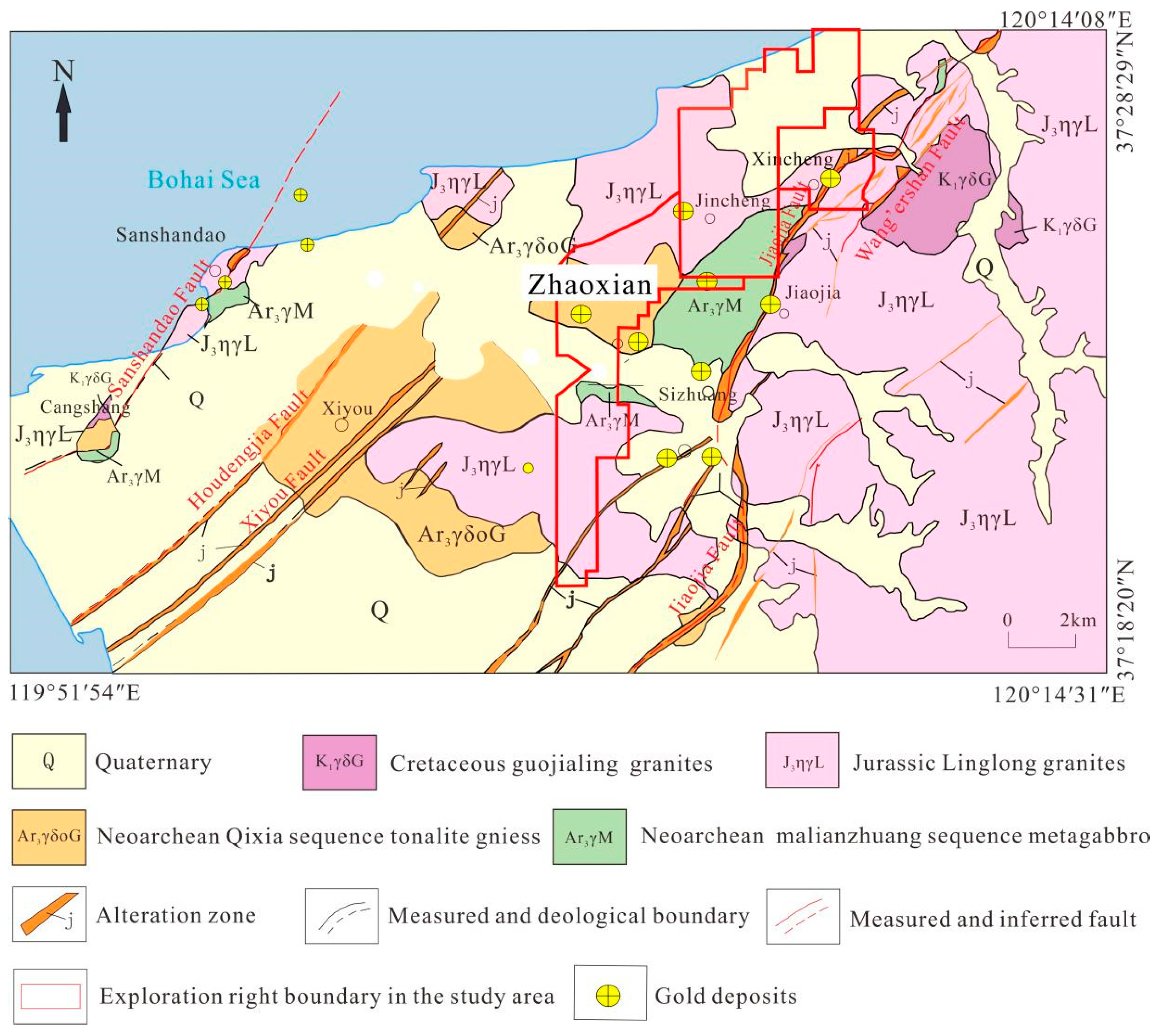

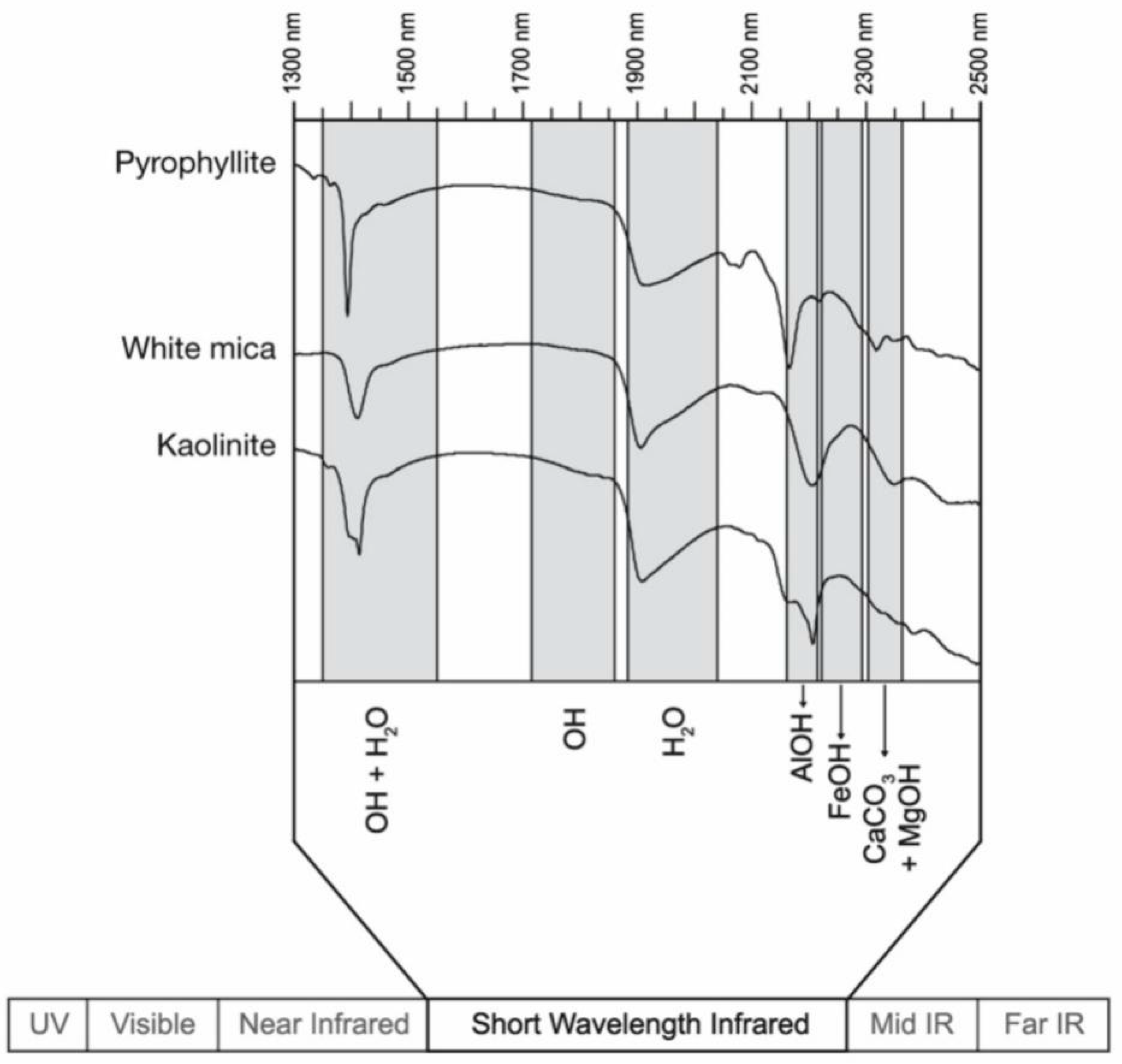
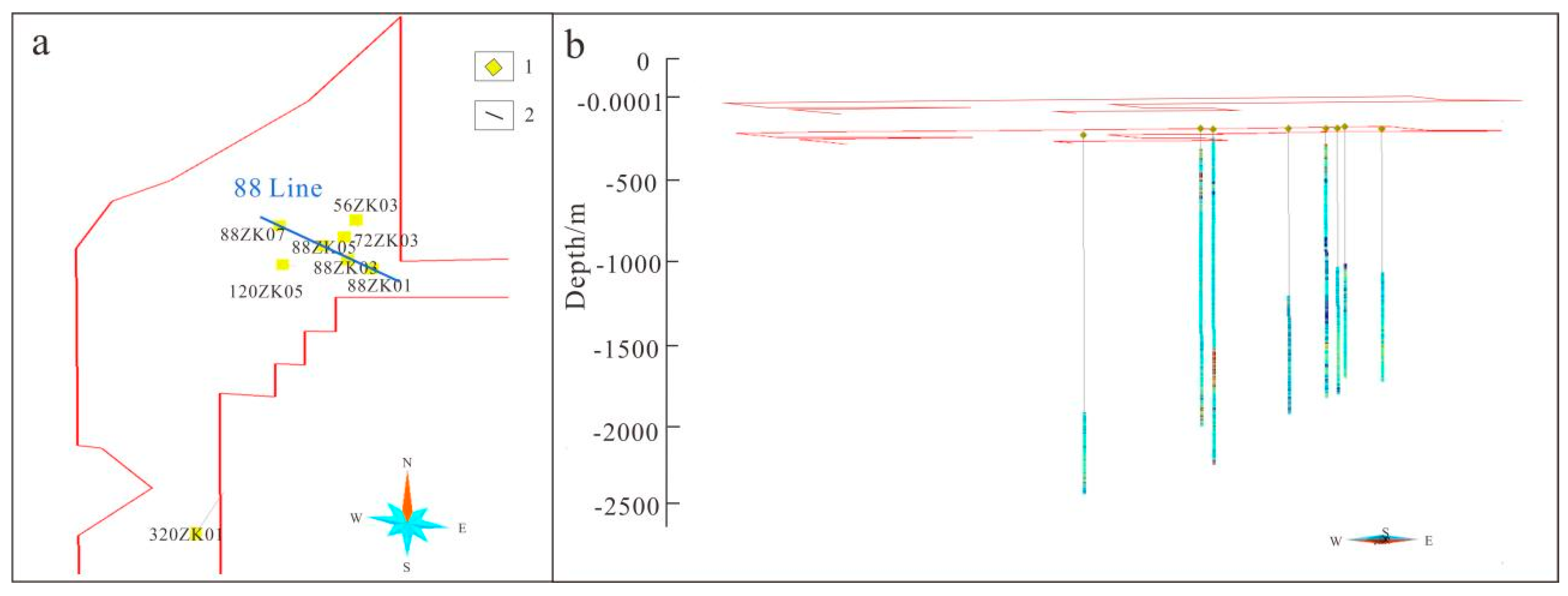
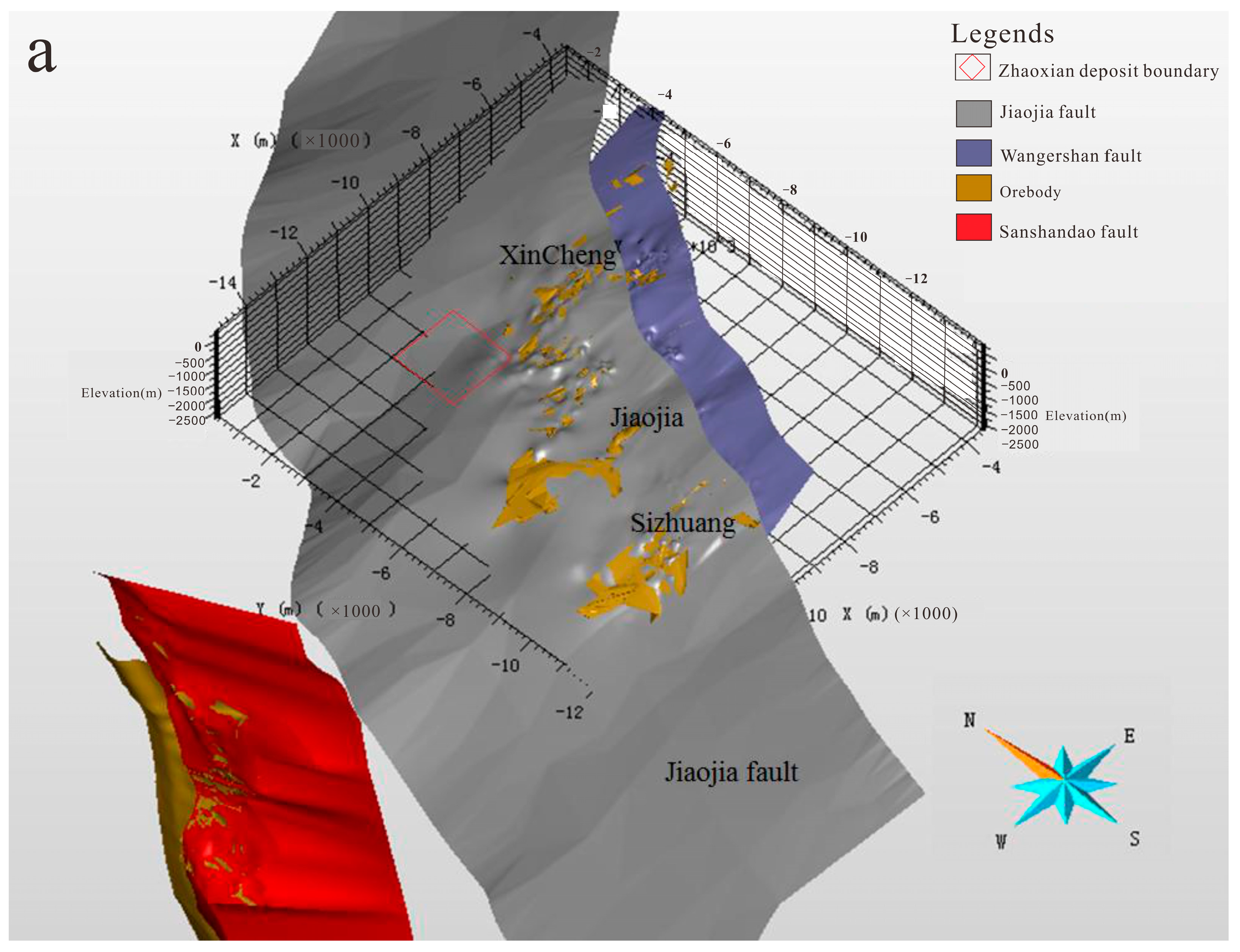

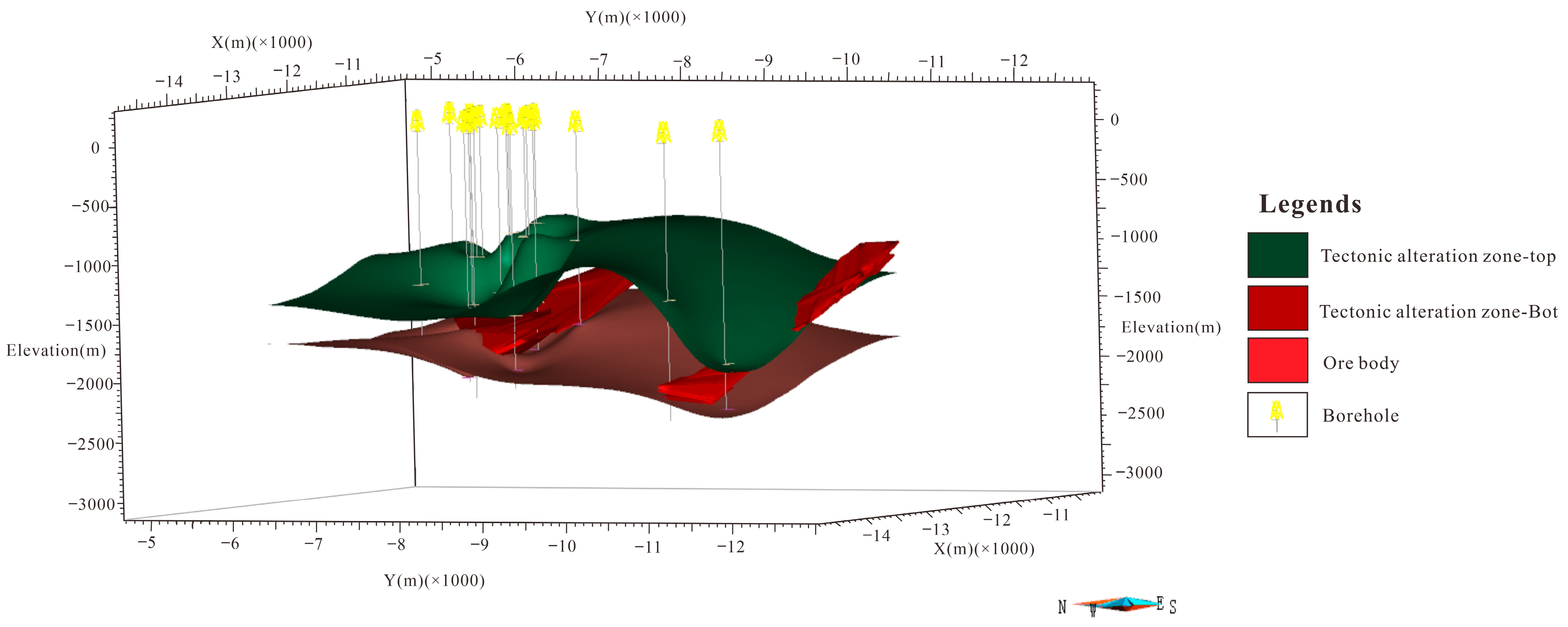
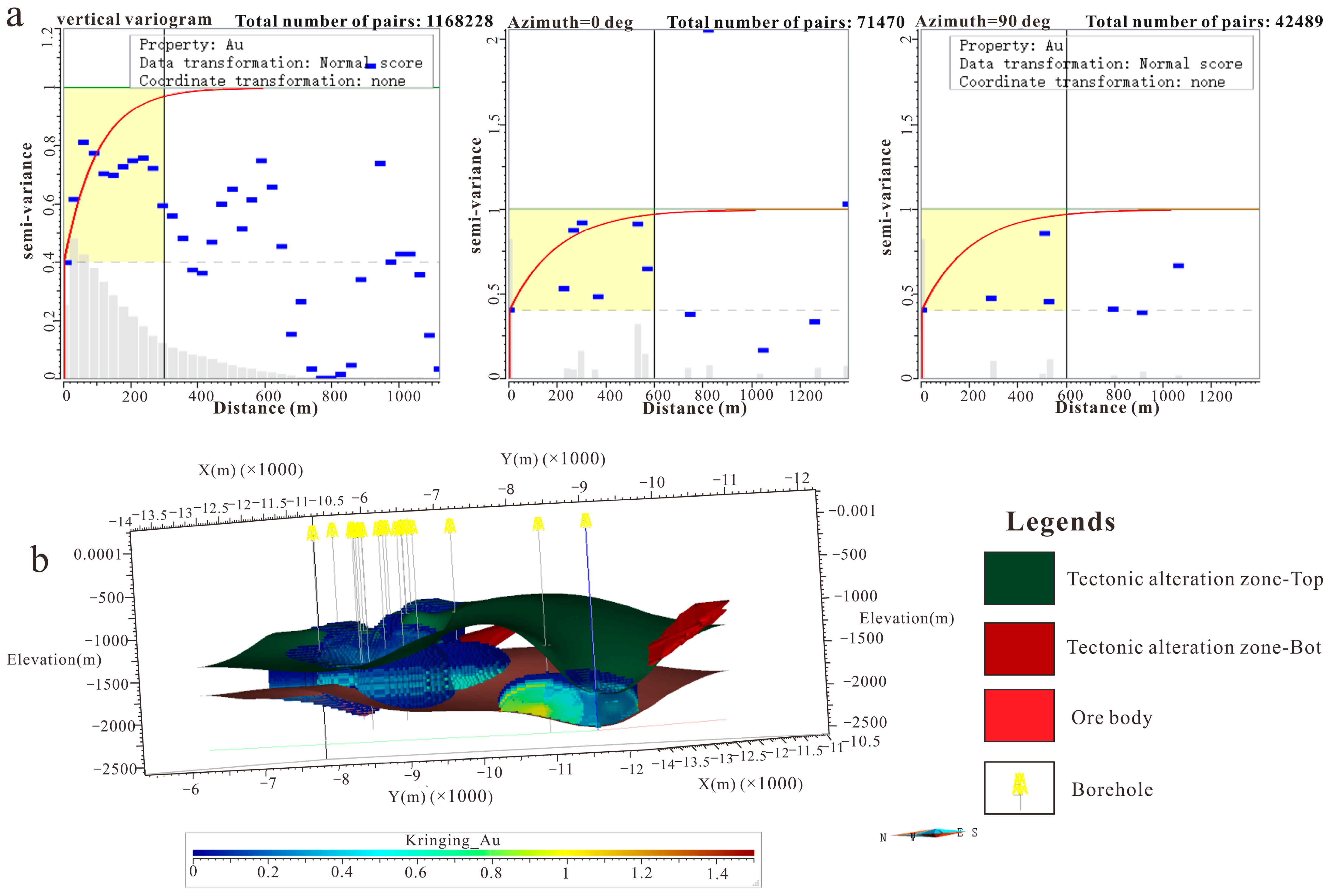

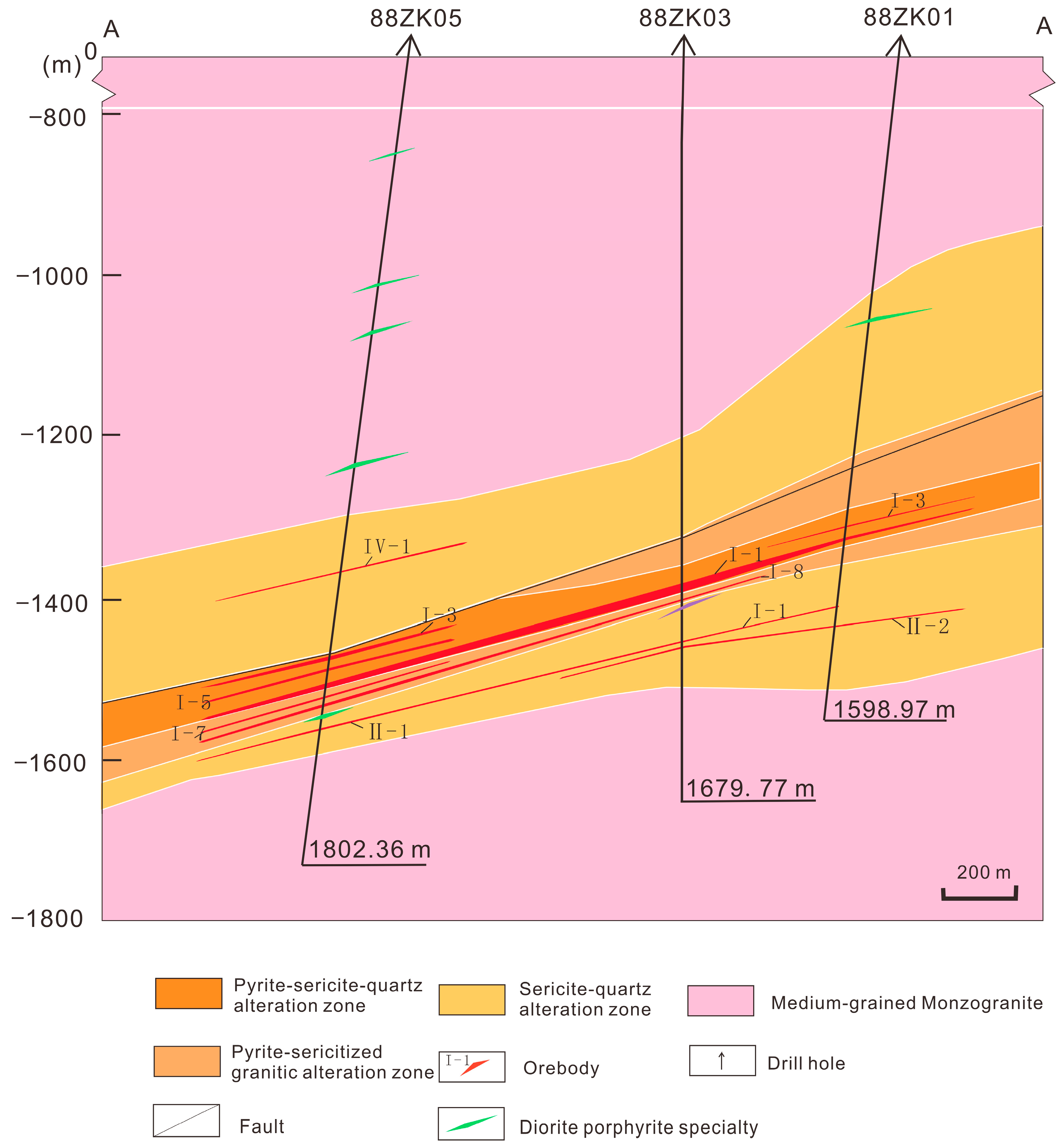


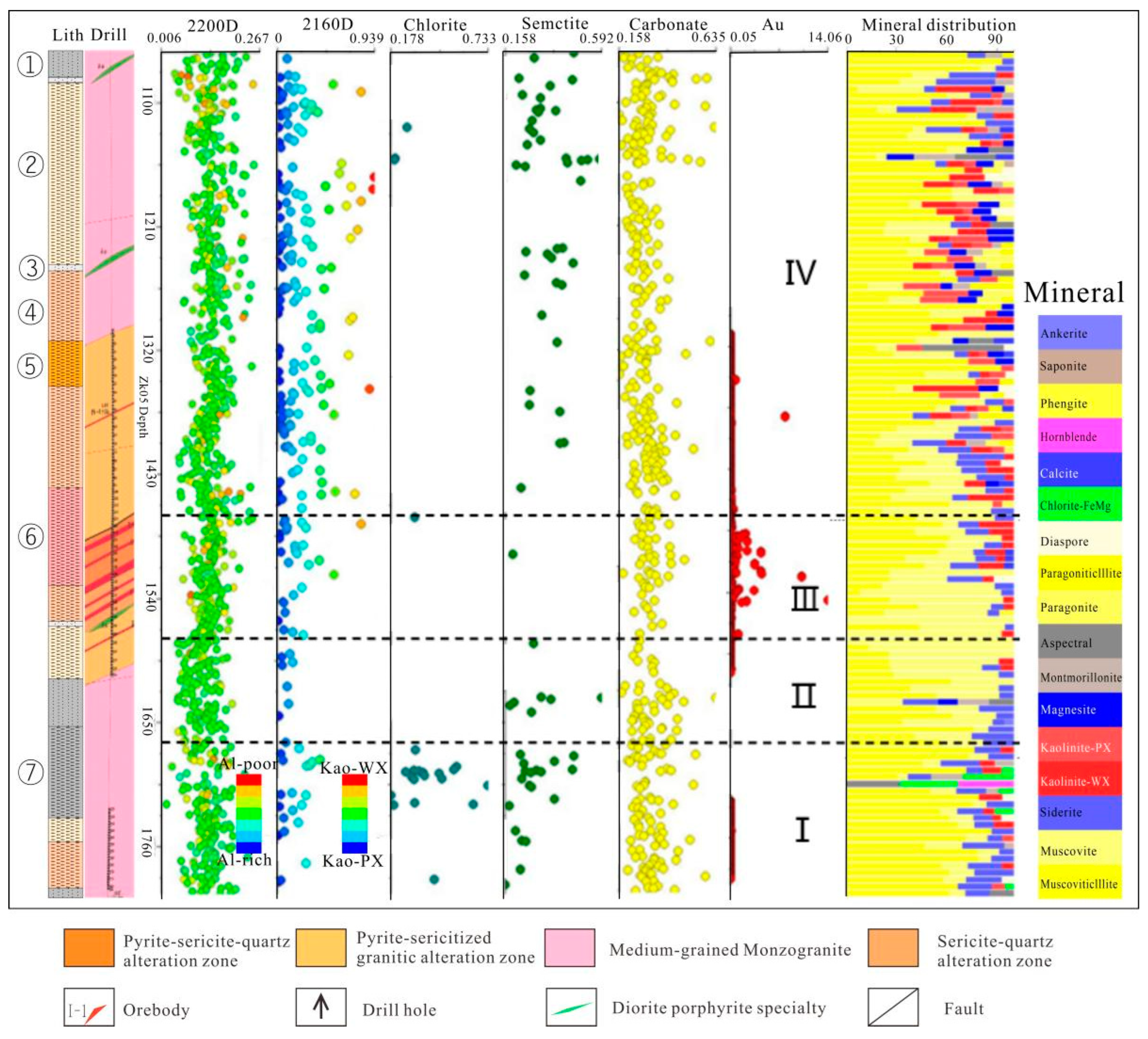
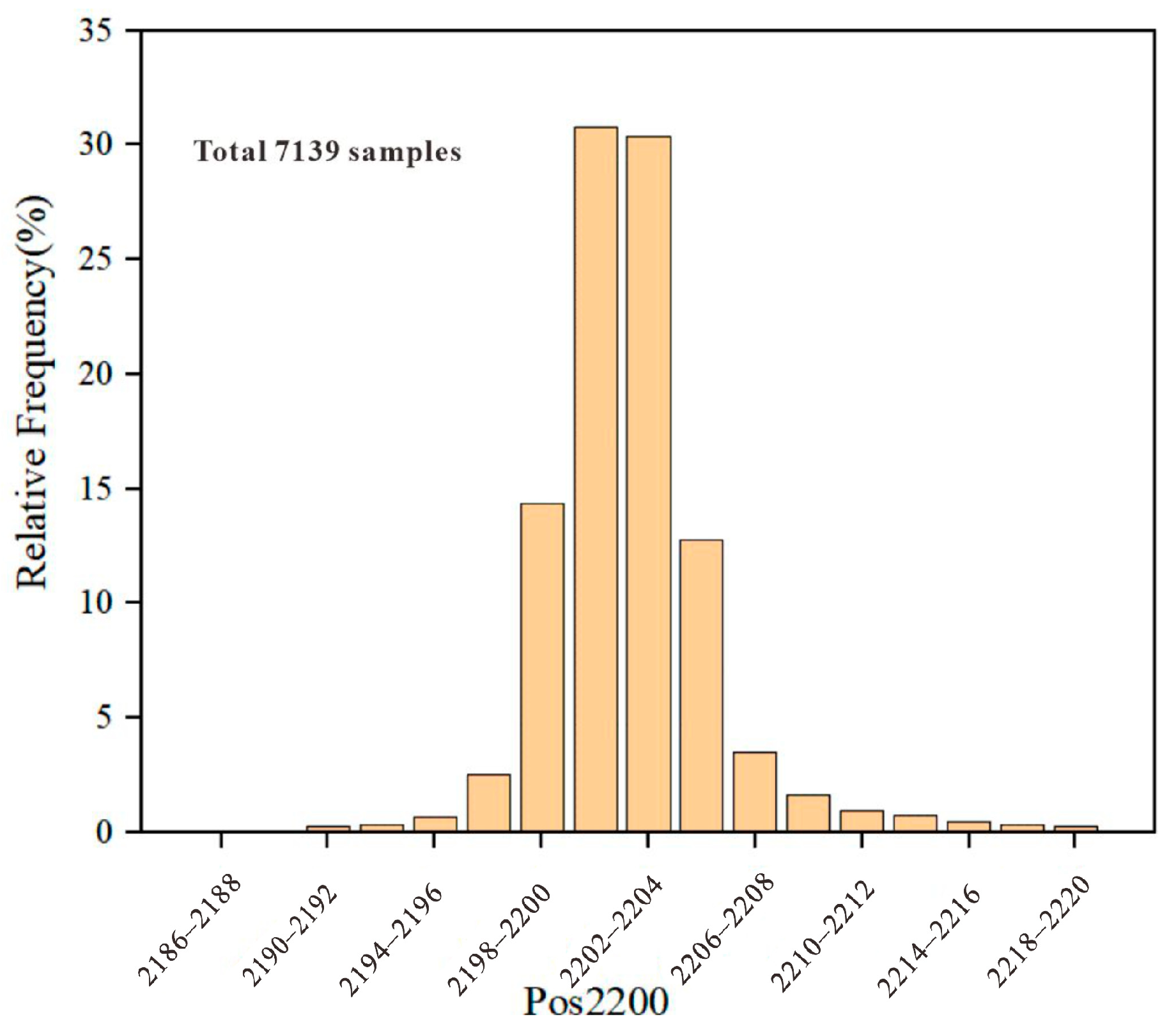
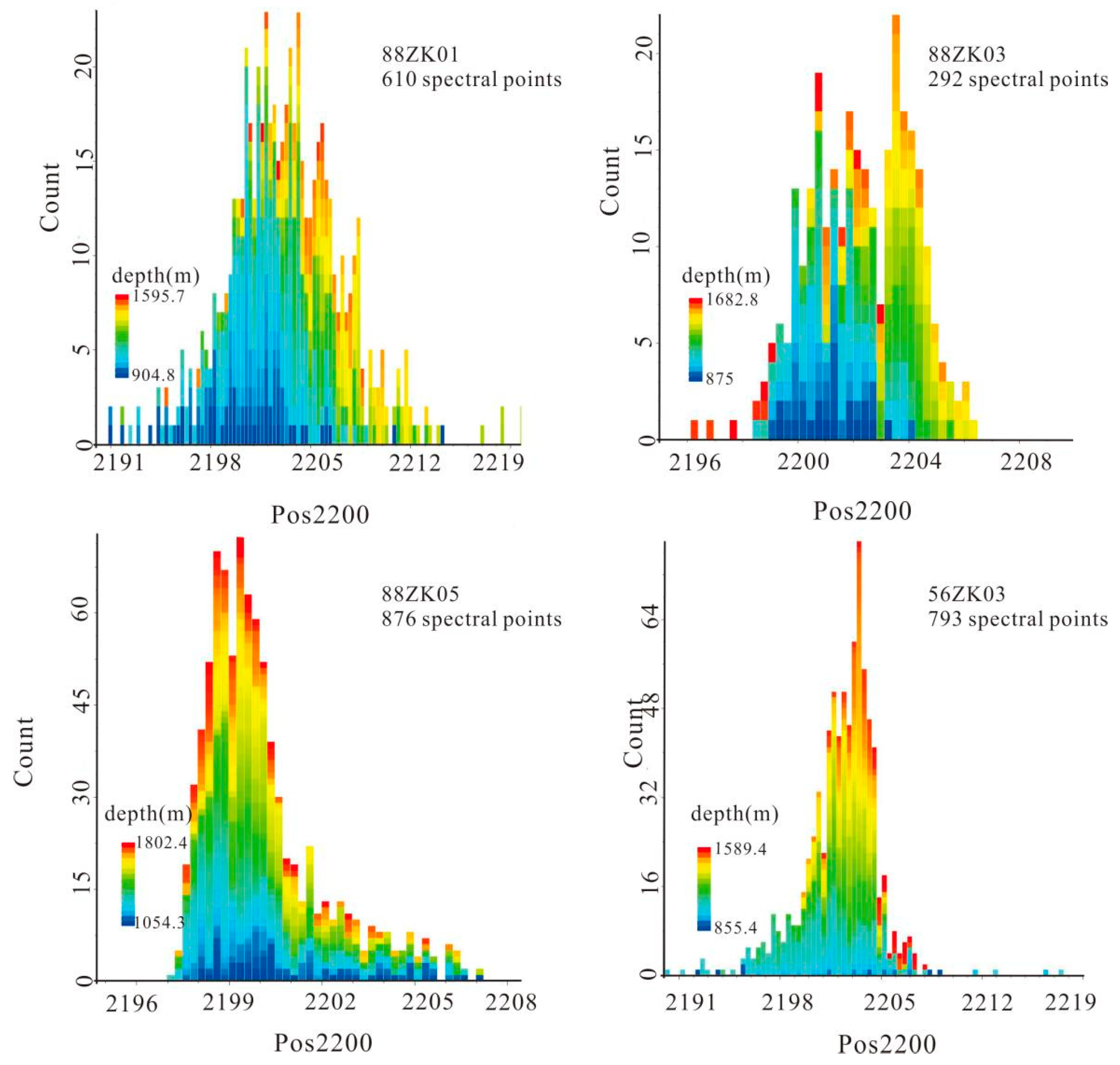
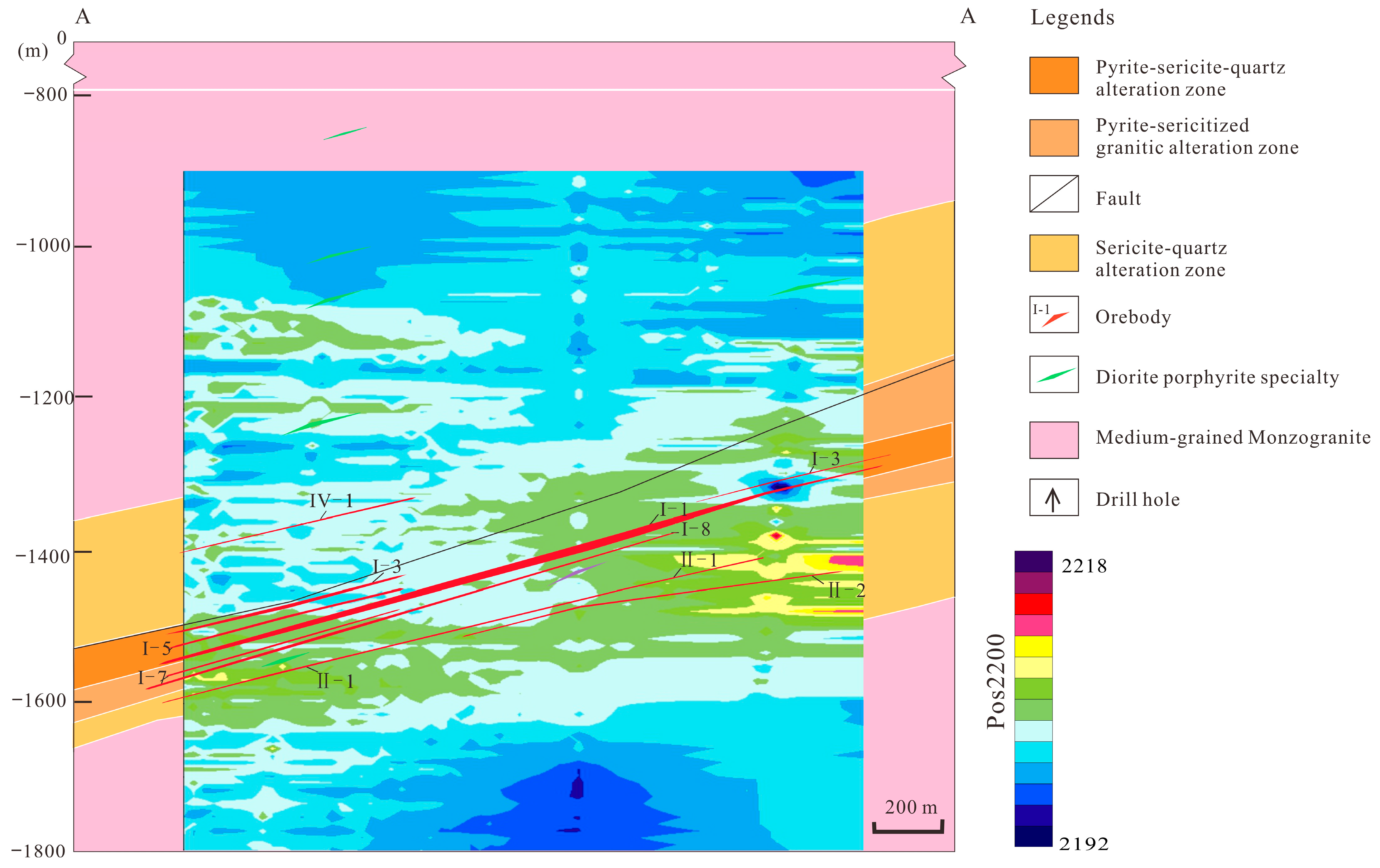
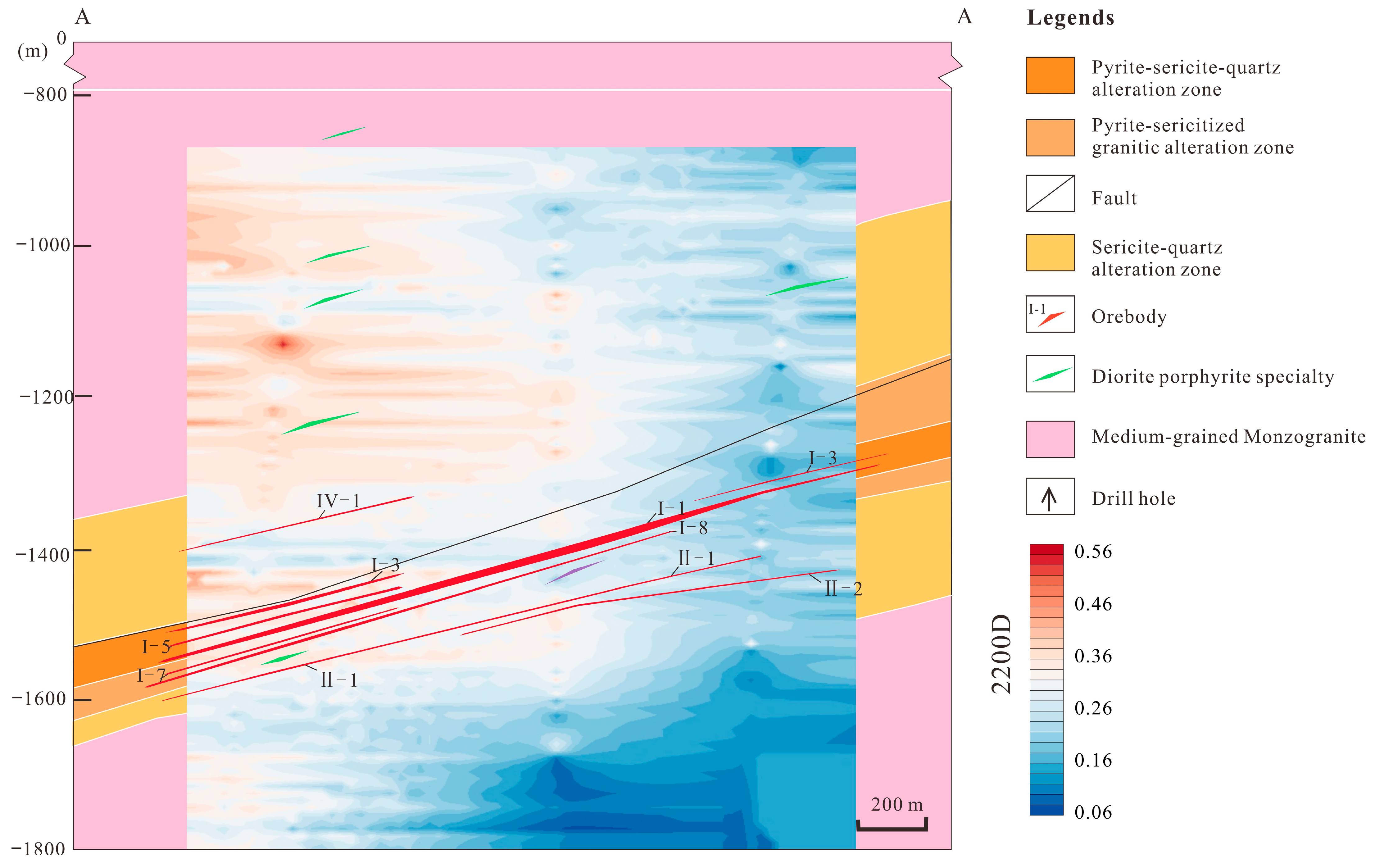

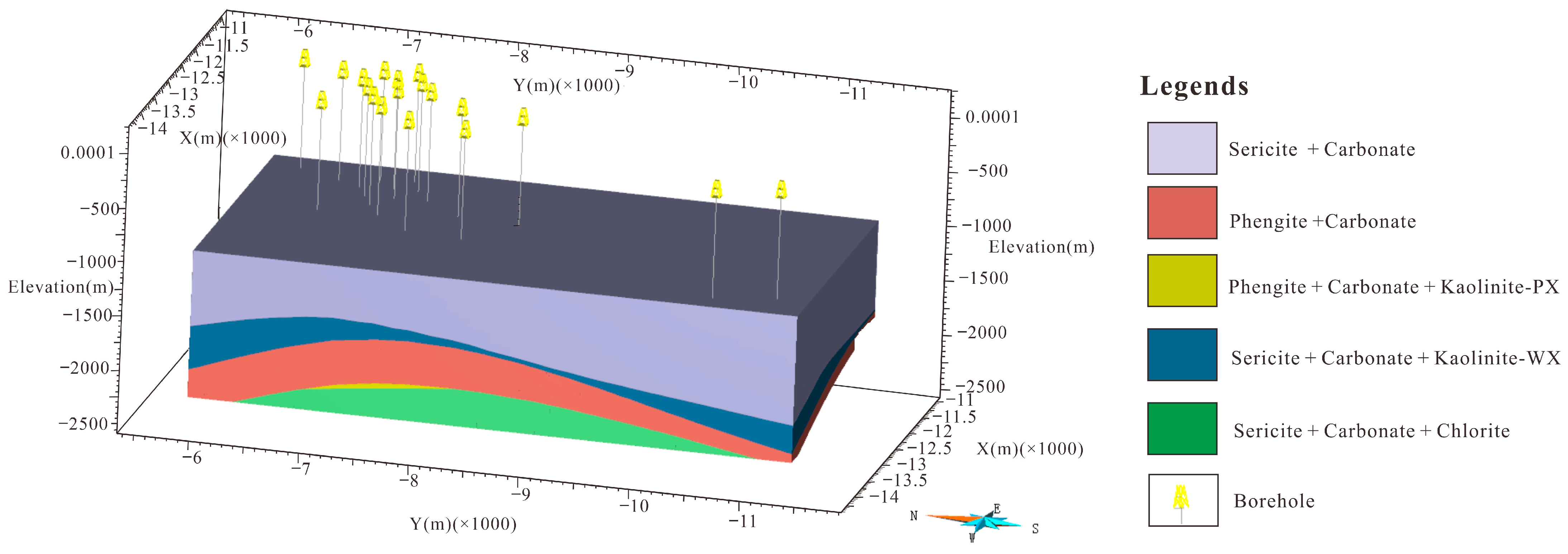
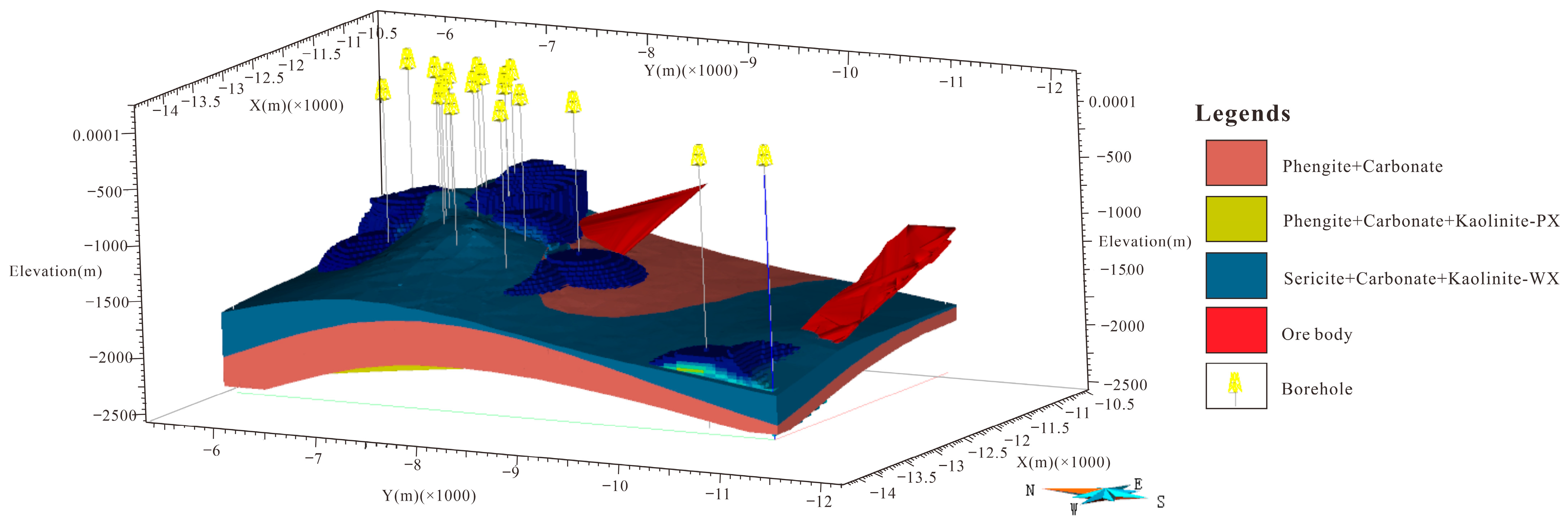
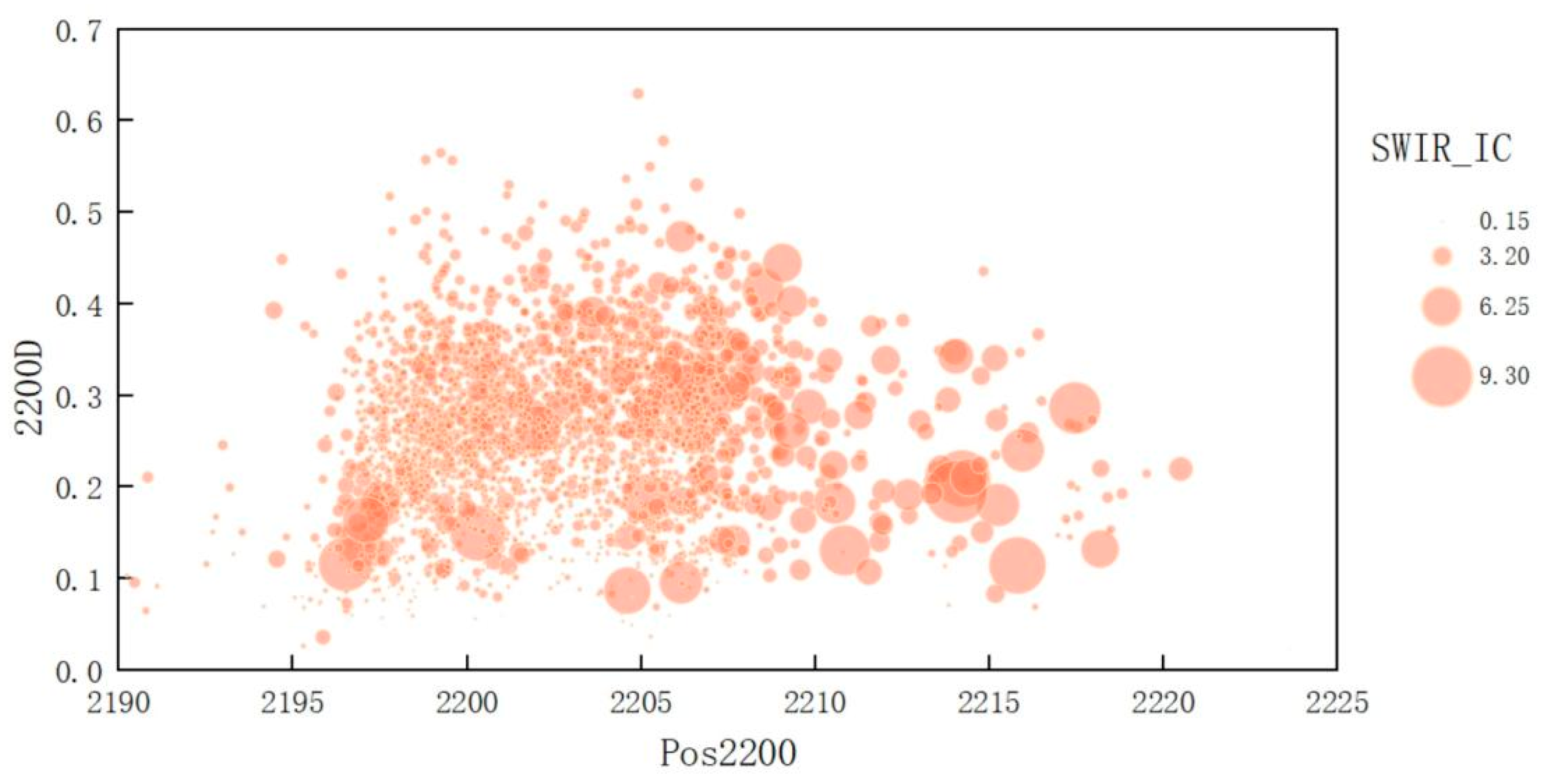

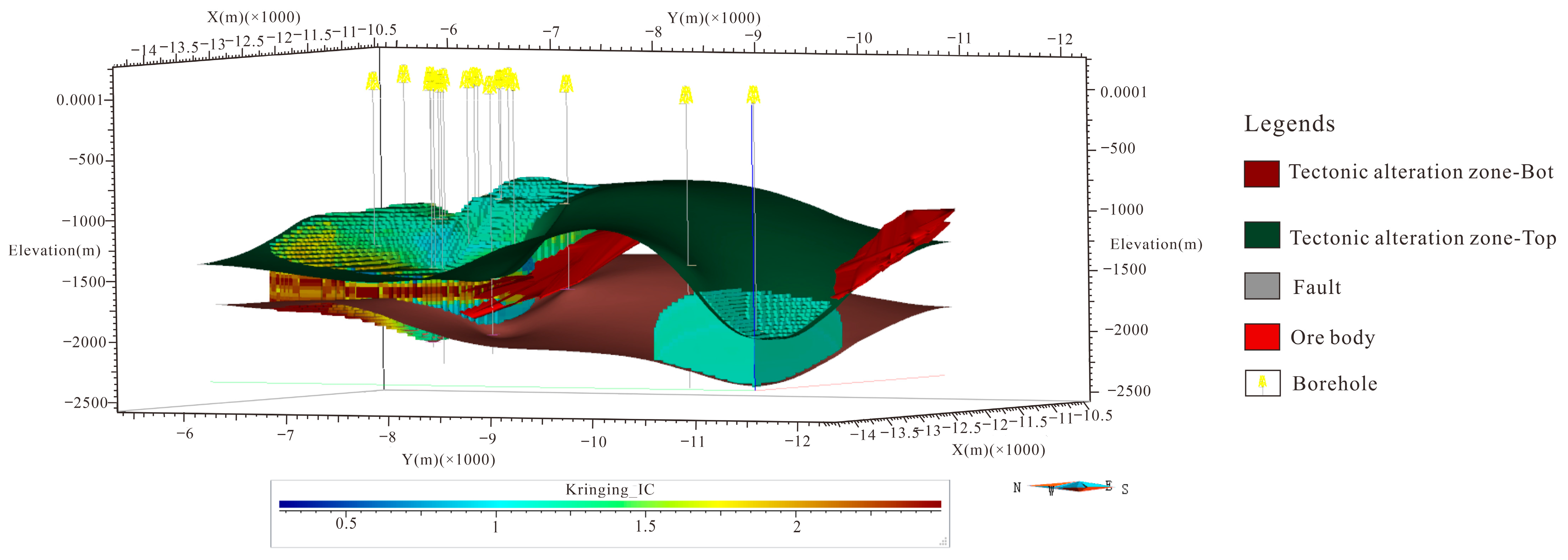
| Metallogenic Stage | Pyrite Distribution | Paragenetic Mineral Assemblages | Pyrite Form | Degree of Mineralization |
|---|---|---|---|---|
| Pyrite-quartz–sericite stage (I) | Irregular granular or idiomorphic coarse-grained crystals | Pyrite, quartz, sericite | Pyrite quartz vein | Weak |
| Quartz–pyrite stage (II) | Fine-grained heteromorphic, veinlet, reticulate | Pyrite, sericite, chlorite | Pyrite quartz crushing | Strongest |
| Quartz–polymetallic sulfide stage (III) | Fine-grained, veinlet, and disseminated | Quartz, pyrite (chalcopyrite), galena, sphalerite, etc. | Quartz–polymetallic sulfide assemblage | Strongest |
| Quartz–carbonate stage (IV) | Veinlet or reticulate | Quartz, carbonate, and a small amount of pyrite | Intercalation of quartz calcite veins | No |
| Scalar Name | Mineral Group | Plain Description | Base Algorithm |
|---|---|---|---|
| Al–OH feature depth (2200D) | White mica | Relative depth of the absorption feature near 2200 nm wavelength. | On the spectrum with the hull quotient removed, the fourth-order polynomial fitting is performed near the relative absorption depth (near 2200 nm). |
| Al–OH feature wavelength (Pos2200) | White mica | Shift of the absorption feature near 2200 nm because of Tschermak’s substitution of Al in white mica. | On the spectrum with the hull quotient removed, the fourth-order polynomial fitting is performed near the position of the minimum absorption peak. |
| Kaolin group crystallinity (2160D) | Kaolin group | The crystallinity order of the kaolinite group minerals can be indicated by 2160D. The larger the relative value of 2160D, the better the crystallinity order. | On the spectrum with the hull quotient removed, the fourth-order polynomial fitting is performed near the relative absorption depth (near 2160 nm). |
| Fe–OH feature depth (2250D) | Chlorite | Relative absorption depth of absorption feature at 2250 nm wavelength; indicative of Fe–OH mineral abundance. | On the spectrum with the hull quotient removed, the fourth-order polynomial fitting is performed near the relative absorption depth (near 2250 nm). |
| Fe–OH feature wavelength (W2250) | Chlorite | Estimation of Mg/(Mg+Fe) in chlorite, where the wavelength position is caused by Mg, Fe, or relative Al, Fe3+, or Ca content. | The minimum wavelength of 2250 nm absorption of the continuous medium is removed near 2250 nm, which is determined by four-band polynomial fitting around the band with the lowest reflectivity. |
| Mg–OH feature depth (W2350) | Chlorite | Depth of 2350 nm feature, evident in white mica, chlorite, and carbonate; used to separate white mica from Al-smectites, when Al–OH feature is present. | On the spectrum with the hull quotient removed, the fourth-order polynomial fitting is performed near the position of the minimum absorption peak (near 2350 nm). |
Publisher’s Note: MDPI stays neutral with regard to jurisdictional claims in published maps and institutional affiliations. |
© 2022 by the authors. Licensee MDPI, Basel, Switzerland. This article is an open access article distributed under the terms and conditions of the Creative Commons Attribution (CC BY) license (https://creativecommons.org/licenses/by/4.0/).
Share and Cite
Li, B.; Peng, Y.; Zhao, X.; Liu, X.; Wang, G.; Jiang, H.; Wang, H.; Yang, Z. Combining 3D Geological Modeling and 3D Spectral Modeling for Deep Mineral Exploration in the Zhaoxian Gold Deposit, Shandong Province, China. Minerals 2022, 12, 1272. https://doi.org/10.3390/min12101272
Li B, Peng Y, Zhao X, Liu X, Wang G, Jiang H, Wang H, Yang Z. Combining 3D Geological Modeling and 3D Spectral Modeling for Deep Mineral Exploration in the Zhaoxian Gold Deposit, Shandong Province, China. Minerals. 2022; 12(10):1272. https://doi.org/10.3390/min12101272
Chicago/Turabian StyleLi, Bin, Yongming Peng, Xianyong Zhao, Xiaoning Liu, Gongwen Wang, Huiwei Jiang, Hao Wang, and Zhenliang Yang. 2022. "Combining 3D Geological Modeling and 3D Spectral Modeling for Deep Mineral Exploration in the Zhaoxian Gold Deposit, Shandong Province, China" Minerals 12, no. 10: 1272. https://doi.org/10.3390/min12101272
APA StyleLi, B., Peng, Y., Zhao, X., Liu, X., Wang, G., Jiang, H., Wang, H., & Yang, Z. (2022). Combining 3D Geological Modeling and 3D Spectral Modeling for Deep Mineral Exploration in the Zhaoxian Gold Deposit, Shandong Province, China. Minerals, 12(10), 1272. https://doi.org/10.3390/min12101272






